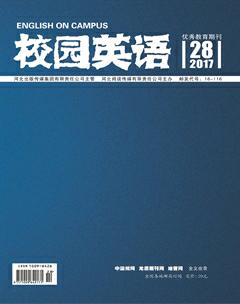基于汉译《杀死一只知更鸟》浅谈卡特福德翻译转换理论的应用
徐赫
【摘要】语言层次和内容结构的再现对于著作英语翻译的要求更高,而西方著作语言是表达性信息文本,更注重内容和语言的表达。卡特福德翻译转换理论是建立在以牺牲形式对等为原则的基础之上,更侧重于语义对等的翻译策略。本文利用转换理论,基于《杀死一只知更鸟》英语翻译,进行应用和对比,旨在为英语汉译提供新的视角。
【关键词】转换理论 语义翻译
【Abstract】It is higher and more stringent for the translation of the famous English books, and the books are the expression information text and should be paid more attention to express its content and language. Catfords translation shifts are grounded on the sacrifice of formal correspondence, which attaches more importance to “semantic equivalence”. This paper uses shifts to The Killing of Mockingbird, in order to offer a brand-new perspective for its translation.
【Key words】Shift; Semantic Translation
一、引言
阅读西方著作是我国公众获取知识和开拓眼界的方式。就西方名著翻译来讲,如何提高翻译质量已成为当今翻译工作者关注的焦点。本文以《杀死一只知更鸟》为例,具体分析卡特福德翻译转换理论在英译汉中的应用。
二、卡特福德翻译转换理论在翻译中的可操作性和实用性
卡特卡特福德在《翻译语言学理论》中认为,从源语文本到目的语的翻译过程,发生了语言的转换,分别为范畴转换和层次转换。本文结合所选文本,基于转换理对句法层次进行分析。
三、卡特福德翻译转换在翻译中的应用
例1 If she was on the porch when we passed, we would be raked by her wrathful gaze, subjected to ruthless interrogation regarding our behavior, and given a melancholy prediction on what we would amount to when we grew up, which was always nothing.
译文:如果我们经过时她坐在廊上,我们就要被她用愤怒的眼光扫来扫去,就我们的举止遭受她残酷的质问,还要接受她对我们未来的恶意预测:毫无疑问,我们俩都会成为无能之辈。
本例难点为主句we would be后接了三個被动语态,be raked by使用被子结构,译为 “被她用愤怒的眼光”,be subjected to省去被动句,译为“遭受”,be given化被动为主动,译为“接受”。例1中的几处状语,在译文中的位置也发生了变化。when we passed和regarding our behavior在原语中置于句尾,但在翻译过程中按照汉语习惯,一般调整到句首。
例2 I pulled at his sleeve, and we were followed up the sidewalk by a philippic on our familys moral degeneration, the major premise of which was that half the Finches were in the asylum anyway, but if our mother were living we would not have come to such a state.
译文:我扯了扯他的袖子,俩人便沿着人行道走去,身后尾随的是对我们家族道德退化的恶毒抨击。它的大前提是:芬奇家无论如何都有一半人待在精神病院里,但如果我们的母亲还在世,我们不会堕落到这种地步。
例2中pulled翻译为 “扯了扯”,生动形象翻译出主人公的行动;本句中最大的难点是“the major premise of which was that”,译文采用断句将主语单独成短句,which指代“a philippic on our familys moral degeneration”,that引导表语从句。
例3 He sat by the windows, hunched down in a rocking chair, scowling, waiting.
译文:他缩在窗前的摇椅里,皱着眉头,紧张地等待。
本例省译了sat直接翻译了hunched down;scowling,waiting都进行了增译,再现原文描绘画面和主人公感受。
四、结语
卡氏翻译转换理论从词汇、短语和句子等基本层面出发,以原文和译文关系的研究为重点。本文依据卡氏翻译转换理论,对《杀死一只知更鸟》汉译过程中长难句翻译实践的分析,不仅理论支撑了其文本的翻译,也为此类文本翻译研究提供了借鉴方法。
参考文献:
[1]Catford,J.A Linguistic Theory of Translation.[M].London: Oxford University Press,1965.
[2]刘宓庆.新编当代翻译理论[M].北京:中国对外翻译出版公司,2005.
[3]郭建中.文化与翻译[M].北京:中国对外翻译出版公司,2000.
[4]陈宏薇.新实用汉译英教程[M].武汉:湖北教育出版社,2000: 152.endprint

